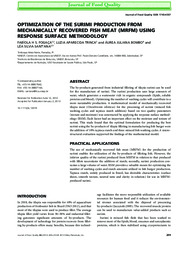Optimization of the surimi production from mechanically recovered fish meat (mrfm) using response surface methodology.
Optimization of the surimi production from mechanically recovered fish meat (mrfm) using response surface methodology.
Author(s): FOGACA, F. H. dos S.; TRINCA, L. A.; BOMBO, A. J.; SANT'ANA, L. S.
Summary: The by-products generated from industrial filleting of tilapia surimi can be used for the manufacture of surimi. The surimi production uses large amounts of water, which generates a wastewater rich in organic compounds (lipids, soluble proteins and blood). Optimizing the number of washing cycles will contribute to a more sustainable production. A mathematical model of mechanically recovered tilapia meat (Oreochromis niloticus) for the processing of surimi (minced fish washing cycles and tapioca starch addition) based on two quality parameters (texture and moisture) was constructed by applying the response surface methodology (RSM). Each factor had an important effect on the moisture and texture of surimi. This study found that the optimal formulation for producing the best surimi using the by-products of tilapia filleting in manufacturing fish burger were the addition of 10% tapioca starch and three minced fish washing cycles. A microstructural evaluation supported the findings of the mathematical model.
Publication year: 2013
Types of publication: Journal article
Unit: Embrapa Mid-North
Observation
Some of Embrapa's publications are published as ePub files. To read them, use or download one of the following free software options to your computer or mobile device. Android: Google Play Books; IOS: iBooks; Windows and Linux: Calibre.
Access other publications
Access the Agricultural Research Database (BDPA) to consult Embrapa's full library collection and records.
Visit Embrapa Bookstore to purchase books and other publications sold by Embrapa.

